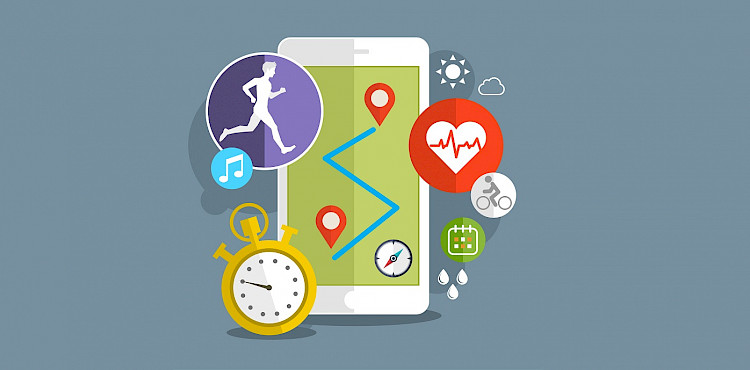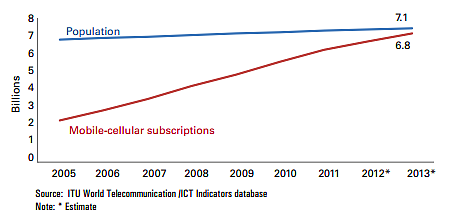Digital health - disrupting healthcare technology and democratizing health care services
31 May 2016 — Health care is traditionally a very conservative and slow-moving industry, while IT technology that can potentially benefit this industry is growing at a faster speed than ever before. Digital technology is disrupting health care and shifting its structure.

Download this post (PDF)
This article originally appeared as a post in LG CNS BLOG (www.lgcnsblog.com) on 31.05.2016. Reproduced here with the kind permission of LG CNS.
Most people with a modern smartphone have experienced getting notifications about their physical activity from a preinstalled health tracker. Steps, calorie consumption, pace are just a few of the quantities being measured. Activity tracking features are included in many mobile devices these days, pulling in users to the “quantified self” movement. Human body activity measurables are being transferred into digital datasets that can provide insightful analytics.
Venture capital investments have proliferated in this area[1] with fitness-related wearable devices like Fitbit, JawBone, or LG Lifeband becoming part of many peoples’ everyday lives. Health tracking and recording applications like Noom[2], that enable users to record daily food intake and activity, or Glow[3], that tracks female periods and fertility, have gained popularity and help to guide users towards a healthier lifestyle. To ensure proper rest, a plethora of sleep trackers exist as well[4].

LG Lifeband (Source: http://www.lg.com/us/mobile-accessories/lg-FB84-BM-activity-tracker)
The natural next step of quantified self would be to make use of this data for health care purposes. However, it is not easy to spot high-tech solutions that apply to actual life-saving medial scenarios. Even Google had to declare its health venture a failure[5] back in 2011.Health tracking apps and devices are generally not acknowledged by doctors. In this blog we take a closer look at where digital health stands today, and where it can be expected to go in the future.
Digital health disruption through IoT, Big Data and AI


Many technologies can be linked to health related applications; most of the key technologies have already been covered in our previous blog posts[6][7][8][9].Technologies in digital health include:
- Sensors and the Internet of Things: Sensors have advanced significantly, with Bluetooth and other wireless technology, enabling enhanced data collection and mobility. Combined with the prevalence of mobile and smart devices, it has become easier than ever to record sensory data and share between devices. For example, a typical fitness band includes a 3-axis accelerometer that tracks movement in all directions, a gyroscope that measures orientation and rotation, and an altimeter that measures the altitude[10]. Some even include temperature and heart rate sensors. This data is then sent wirelessly to the phone where it is stored. In fact, a report by McKinsey[11] predicts that global IoT-driven economic value for health care and medical devices will reach 600BUSD– 800BUSD by 2018.
- The Cloud and Big Data: With each and every movement being tracked 24 hours in a typical fitness band, the amount of data grows quickly. Because of this, the Cloud is needed to store the exploding amount of health and activity data. Companies providing fitness tracking and cloud storage services obtain enormous datasets as a result, which they can use to gain insights.
- Artificial Intelligence: Having computers to detect trends with the health and fitness data provides further insight. AI technology has the potential to replace certain tasks currently handled by physicians. For example, Lunit can visually analyze medical images, like X-rays or mammograms and make diagnoses by applying deep learning technology[12]. There is even an entire academic journal dedicated to Artificial Intelligence in medicine, published by Elsevier[13].
These technologies are applied to health care across multiple domains. While a more complete list can be found online, this blog will focus on three main domains; namely wearable devices, mHealth (mobile applications), and telehealth (remote healthcare services)[14].
- Wearable devices: Continuous data can be collected through wearable biosensors. While fitness-related wearables are most well-known, similar technology is actually used for medical use, like controlling chronic conditions. For instance, Care Predict[15] makes sensor-packed bracelets for seniors, which alerts the caregiver if anything is out of the ordinary. By doing so, Care Predict aims to detect early signs of age-related illnesses. Wearable devices have also been proven useful for post-surgery recovery in cardiac patients and diabetic patients in monitoring their health and taking self-regulatory actions to control their symptoms[16].
- mHealth: Not only do wearable devices provide more data, but mobile phone applications are being used to make health care more easily accessible. It can be as simple as an app reminding the user of a doctor’s appointment or when to take a pill, or a portable device that measures a person’s heart rate on the go. According to a survey conducted by Healthcare Information and Management Systems Society (HIMSS) North America, more than 90 percent of medical institutions are utilizing mobile devices within their organizations to engage patients in their care[17]. mHealth simply implies real-time access that supports patient engagement. Patients who have difficulties reaching a medical facility can get more timely and convenient support when needed.
- Telehealth: Telehealth makes it possible for doctors to reach a larger number of patients and can help manage chronic conditions without having to visit the doctor every time the patient encounters a trivial problem[18].
In addition to personal health care, researchers in medicine and life science are also taking advantage of the new technologies and growing datasets. While quantitative health data is exploding due to sensors and apps, qualitative data is also increasing through social media and crowd sourcing platforms. Websites like PatientsLikeMe[19] provide a platform and forum to discuss symptoms, drug side effects, and qualitative assessments of treatments. Medical institutions are getting savvy with this kind of information and applying Big Data analytics to discover new insights. This was also discussed in our previous blog post.
Evidence-Based Medicine[20] (EBM) may become more and more prevalent once enough data is gathered. The aim is to apply the latest and most objective treatment plans to individual patients. This can gain more traction as increased amounts of objective data provide a solid evidence for clinical judgments.
Lastly, genomics is a field that has the potential to flourish when combined with big data. The data requirements of sequencing and storing genome data is extraordinarily large, with biologists warning that this data will even exceed the resources used for Twitter and Youtube[21]. Big data analytics techniques are therefore essential in extracting insights.
The great divide between patients and physicians

Currently there are two categories in digital health services: patient-driven and physician-driven services. Patient-driven services include wearable devices or mobile apps that track health data. Demand is driven by consumers wanting to follow their own health and maintain a healthy lifestyle. On the other hand, physician-driven services are those a patient can expect when visiting a doctor’s office, like online reservation for an appointment or getting text alerts on when to refill your prescription. The two seem to have little or no connection – physicians do not look at patient-generated health data when making diagnostics or suggesting treatments, even though this kind of data is growing rapidly. Also the speed of innovation and digitization seems much slower for physician-driven services. The reason for this divide is perhaps the rigid nature of the medical industry. There is a high entry barrier to this industry, which is tightly protected by government regulations and preexisting medical industry players who prefer status quo[22]. Also, as medical services are more of a necessity than a consumer choice, the medical industry feels little to no threat that usually drives other industries to seek innovation. There seems to be a gap in what healthcare institutes can provide and what patients want.
There are obvious reasons why health care is under strict regulations – confidentiality is critical and there are legal liabilities linked to providing non-professional medical advice. Information integrity can be compromised if data is not recorded in a controlled environment[23]. There has been severe criticism about applying Silicon Valley startup techniques to healthcare related products. For example, Theramos, a disruptive blood-testing startup, is withdrawing all of its results from 2014 and 2015 as it failed to meet accuracy requirements[24]. Applying the “Silicon Valley tech playbook” is perilous, if it means taking an unfinished product to market in blood testing[25].
Because of strict regulations posed on healthcare related applications, consumer apps have limitations on the extent of information and help they can give (which is why most of them focus on fitness, rather than formal healthcare). Notably, “23andMe”, a consumer-facing genetics diagnostics kit, was banned from providing genetics information regarding hereditary diseases because of regulations[26].
The wearable sector is seeing a drop in investment[27] as the value proposition is proving to be limited. Expanding to real health care could change the situation. This route of innovation is not without its barriers—companies have to find their way through the complicated health care value chain, which involves not only the physicians but also insurers that finance the services and governmental organizations that act as gatekeepers for new solutions.
Leapfrog innovations expected to democratize healthcare
Healthcare institutes have a long way to go to prepare an infrastructure that could actually make use of the enormous amount of data available. A survey conducted by WHO found that in more than 40% of countries local policies are one of the main barriers for mHealth implementation[28]. Implementation of digital health technologies can be expected to be slow and painful. There are some limited efforts to incorporate patient-generated health data in a clinical setting, such as the FDA publishing a guideline for developers creating medical mobile apps[29]. However, again, regulations and fear of making wrong clinical decisions are hindering significant integration.
Innovation will be focused on less-developed countries where regulations are not that stringent and health institutional infrastructure is less developed[30][31]. Mobile phones are now reaching even the most remote corners of the world. Developing countries jump over fixed line infrastructure and install high-speed 4G networks. As seen in Figure 1, mobile cellular subscriptions are quickly catching up with the entire world’s population. Some analysts even state that mobile phones are now more accessible than basic essentials like electricity or drinking water[32].

Figure 1. Global mobile cellular subscriptions and world population[33]
Breakthroughs in sensor and medical technologies are helping citizens of developing countries access health care services in a more cost-efficient and convenient way. For example, EyeNetra[34] is a startup that produces mobile device add-ons that can accurately measure your vision. It is effectively replacing a doctor’s visit for vision-testing so even people in remote areas can get prescription glasses. Digital healthcare can also arise from philanthropic efforts, such as eradicating preventable diseases in third world countries[35]. Developed countries may follow these innovations once regulatory bodies (like the FDA) finally catch up and embrace the democratization of healthcare[36].
Armed with mobile technology and consumer-focused innovations, health care has the possibility of being democratized. From a global perspective, this means underprivileged people can enjoy a healthier life without being threatened by curable diseases. For developed countries, this means that patients no longer have to rely solely on a doctor’s expertise for their own health and can actively make informed decisions—the data and insight is slowly coming under the patient’s own control.
We must prepare ourselves for a future where health care breaks free from its old ways and embraces the digital revolution. Technology startups should not be discouraged by stringent regulations and should seek opportunities with a global mindset. Health care institutions and physicians should accept the disruptive potential of digital technology, and look at the opportunities with an open mind. We are all to benefit from this, if we address these opportunities in a responsible manner.
The authors would like to thank Dr. Wei Wang for her contribution and support to this topic.
Further reading and references:
This blog is based on a broad range of articles, books and reports. Some of the more interesting ones are listed below.
http://healthcare.mckinsey.com/sites/default/files/Healthcare_WhitePaper_screen_April17.pdf
https://hbr.org/resources/pdfs/comm/sap/18826_HBR_SAP_Healthcare_Aug_2014.pdf
http://www.nytimes.com/2010/05/02/magazine/02self-measurement-t.html
http://www.economist.com/node/21548493
http://www.wired.com/2014/08/enlitic/
http://www.nytimes.com/2015/12/08/upshot/your-new-medical-team-algorithms-and-physicians.html?_r=1
http://arstechnica.com/information-technology/2016/03/artificial-intelligence-in-healthcare/
http://techcrunch.com/2014/09/22/the-reinvention-of-medicine-dr-algorithm-version-0-7-and-beyond/
http://techcrunch.com/2012/01/10/doctors-or-algorithms/
http://www.wired.com/insights/2015/01/quantified-self-enterprise/
https://www.technologyreview.com/s/424390/the-measured-life/
http://insights.wired.com/profiles/blogs/improving-patient-care-with-wearables#axzz48AgqmrU7
http://www.bbc.com/future/story/20130102-self-track-route-to-a-better-life
http://quantifiedself.com/2013/02/larry_smarr_croneshope_in_data/
http://medcitynews.com/2016/02/quantified-self-kool-aid/
http://www.forbes.com/sites/bernardmarr/2015/04/21/how-big-data-is-changing-healthcare/#5471ede832d9
http://healthitanalytics.com/news/fda-big-data-standards-interoperability-needed-for-analytics
http://www.jibestream.com/blog/how-wearable-devices-are-improving-patient-care
https://hbr.org/2011/07/what-googles-quiet-failure-say/
http://techcrunch.com/2011/06/26/why-google-really-failed-money/
http://hitconsultant.net/2014/12/22/7-google-ventures-poised-to-revolutionize-healthcare/
https://www.cbinsights.com/blog/health-tech-trends-2016/
http://www.cio.com/article/3017995/wearable-technology/13-wearable-tech-trends-to-watch-in-2016.html
http://www.nature.com/news/regulation-the-fda-is-overcautious-on-consumer-genomics-1.14527
[1] https://www.cbinsights.com/blog/health-tech-trends-2016/
[2] https://www.noom.com/
[3] https://glowing.com/
[4] http://www.wareable.com/withings/best-sleep-trackers-and-monitors
[5] https://hbr.org/2011/07/what-googles-quiet-failure-say/
[6] http://www.lgcnsblog.com/inside-it/smarthomes-are-coming-who-will-be-in-them/
[7] http://www.lgcnsblog.com/features/public-clouds-growth-and-outlook-addressing-new-opportunities/
[8] http://www.lgcnsblog.com/features/big-data-harnessing-the-big-potential/
[9] http://www.lgcnsblog.com/inside-it/artificial-intelligence-tailored-smart-solutions-today-true-intelligence-tomorrow/
[10] http://www.wareable.com/fitness-trackers/how-your-fitness-tracker-works-1449
[11] McKinsey, Unlocking digital health: Opportunities for the mobile value chain, April 2015
[12] http://lunit.io/
[13] http://www.aiimjournal.com/
[14] Deloitte, 2016 Global life sciences outlook – Moving forward with cautious optimism
[15] https://www.carepredict.com/
[16] http://bmcmedicine.biomedcentral.com/articles/10.1186/s12916-015-0319-2
[17] http://www.healthcare-informatics.com/article/mobile-patient-how-mhealth-tools-are-paving-way-better-care-management
[18] http://www.fiercehealthit.com/story/telehealth-improves-home-management-chronic-disease/2013-12-10
[19] https://www.patientslikeme.com/
[20] http://www.physicianspractice.com/technology/evidence-based-medicine-isnt-going-anywhere
[21] http://www.nature.com/news/genome-researchers-raise-alarm-over-big-data-1.17912
[22] https://hbr.org/2006/05/why-innovation-in-health-care-is-so-hard
[23] https://www.healthport.com/docs/default-source/whitepapers/wp_patientgeneratedhealthdata_120415_web.pdf?sfvrsn=2
[24] http://www.wsj.com/articles/theranos-voids-two-years-of-edison-blood-test-results-1463616976
[25] APM: Marketplace for Thursday, May 19, 2016, interview with John Carreyrou, investigative journalist for WSJ.com
[26] http://www.nature.com/news/regulation-the-fda-is-overcautious-on-consumer-genomics-1.14527
[27] https://www.cbinsights.com/blog/wearable-computing-startup-investing-declines/
[28] http://www.who.int/goe/publications/goe_mhealth_web.pdf
[29] http://www.fda.gov/downloads/MedicalDevices/…/UCM263366.pdf
[30] http://www.nationalacademies.org/hmd/~/media/Files/Report%20Files/2011/Health-IT/Commissioned-paper-Impact-of-Regulation-on-Innovation.pdf
[31] http://www-wds.worldbank.org/external/default/WDSContentServer/IW3P/IB/1991/02/01/000009265_3960930125652/Rendered/PDF/multi0page.pdf
[32] http://www.chetansharma.com/GlobalMobileMarketUpdate2012.htm
[33] http://www.internetworldstats.com/mobile.htm
[34] https://eyenetra.com/
[35] https://www.technologyreview.com/s/601425/in-global-shift-poorer-countries-are-increasingly-the-early-tech-adopters/
[36] http://www.nature.com/news/regulation-the-fda-is-overcautious-on-consumer-genomics-1.14527
Tags
Digital health, Health care









